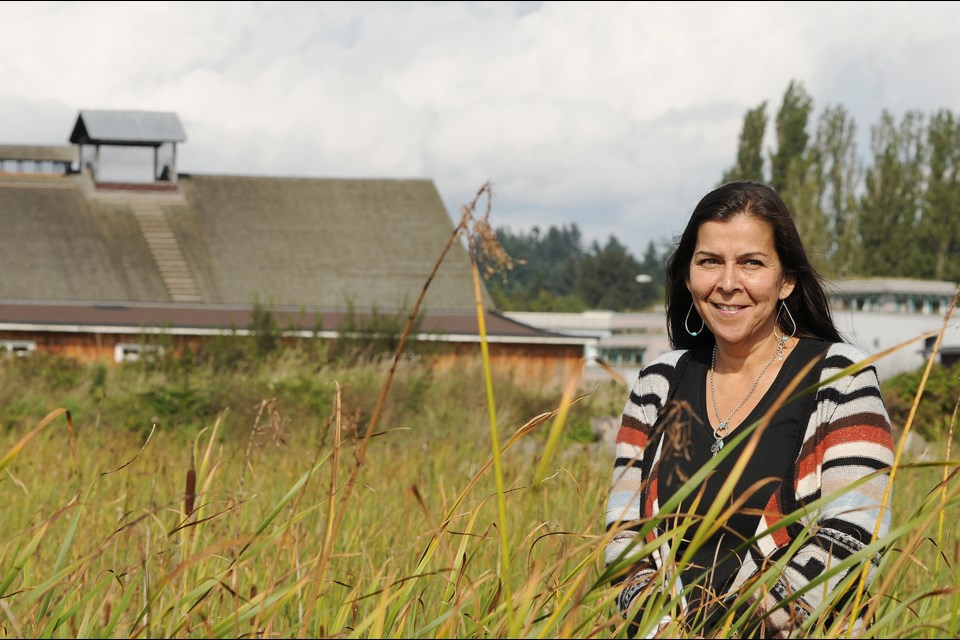When Johnna Sparrow-Crawford looks out her office window, she is reminded of her days growing up on the Musqueam reserve.
It’s easy to remember that time in the 1960s since the family house was located a few steps from where she now works as the band’s communications and protocol coordinator.
Back then, her father Willard was the chief and band manager. He operated the band office from the back of the three-bedroom house, which was next to a small community hall. Vegetable gardens leased to Chinese farmers covered the grounds.
“A lot of our younger people don’t even know this story,” said Sparrow-Crawford, who has nine siblings, including current chief, Wayne Sparrow. “When you look at what we’ve accomplished and where we’ve come, it’s a result of [elders] paving the way.”
The Musqueam’s progress is evident from where Sparrow-Crawford sits. Her office is located in the band’s large two-storey administration building. The family house is now gone and was replaced by a $10 million community centre, which opened in June 2012.
The centre has become a hub for band members, as witnessed during a recent visit by the Courier. The facility was busy with fitness classes, workshops and continuing education programs. Computer labs, a large weight room and an industrial-sized kitchen are other features, along with office space upstairs.
A short drive up the street are two new sports fields — one turf, the other natural grass — which the band also rents to the public. Fitness has become an important part of Musqueam life, with diabetes a health problem in aboriginal communities.
Across from the community centre is one of the showpieces of the band’s progress: a unique and expansive multi-use cultural centre, which opened in June 2011. The circular-shaped structure is meant to resemble a cedar hat and is used for ceremonies and conferences.
A recent addition to the centre is the Musqueam’s new gallery, which opened in August and displays artifacts such as tools, baskets and hats that would normally be found in the Museum of Anthropology at the University of B.C.
Standing outside the new buildings at Salish Drive and Musqueam Avenue, band councillor Wade Grant reflected on what the developments mean for Musqueam. He pointed out band members sitting behind a wall of windows participating in a seminar in the community centre.
“They would never have had an opportunity to do that in the past,” Grant said. “So these buildings and the services they provide represent a hope for the future — a hope for people who want to further their education. But they also represent how far we’ve come.”
That past, however, is always present in the neighbourhood, with the band’s traditional longhouse a short walk from the community centre. An important part of Musqueam culture and heritage, the longhouse is used mainly in the winter.
“If you come down near Musqueam, you’ll hear the drums at night, there are songs still being sung, there are dances still being danced,” said Grant, noting other First Nations from the Pacific Northwest have participated in ceremonies.
While the band’s rich history is important to preserve, Grant said it’s necessary to share the culture and traditions so others learn more about Musqueam and First Nations history, a subject he wasn’t taught in school.
That history also includes the heartbreak of the residential school system, which saw Musqueam children separated from their families and communities, a topic top of mind last week as thousands gathered at the Truth and Reconciliation Commission of Canada events at the Pacific National Exhibition and around the city.
The Musqueam recently planted small cedar trees outside the cultural centre in memory and honour of the survivors of that dark period in Canadian history. Chief Sparrow’s late father, Willard, was a residential school survivor.
“If you walk down the street and ask people about this period, most don’t know anything about it,” said Sparrow, who participated in a ceremony outside Science World last week where various First Nations, including Musqueam, arrived in False Creek by canoe. “It should be part of the history that is taught in the schools.”
Sparrow and Grant, who is the chief’s nephew, welcome visitors to the reserve but recommend first checking in with the band’s administration office. Musqueam offers group and individual tours.
“It’s important for the Musqueam people to take it upon themselves to share a little bit of our history because our history is now Vancouver’s history,” Grant said, pointing out Vancouver is 127 years old while Musqueam people have lived in what is now the Lower Mainland for thousands of years.
[email protected]
twitter.com/Howellings



